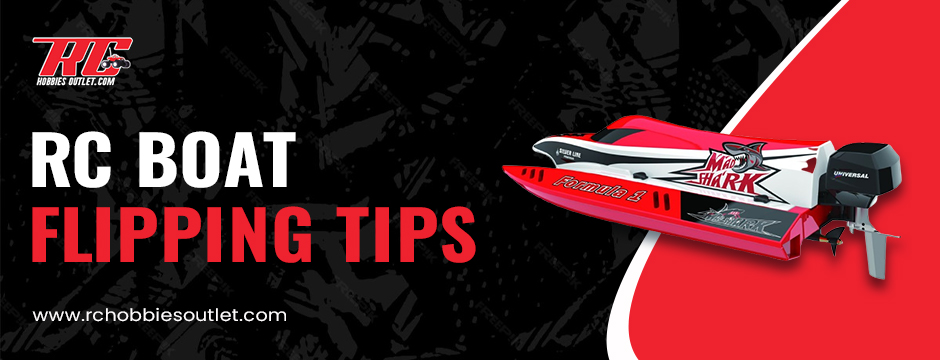Beginner Tips to Stop Your RC Boat From Flipping in the Water
Posted by RC Hobbies Outlet on 29th Oct 2025
RC boating is more than a hobby — it’s a passion that brings thrill and relaxation together. Across Canada, enthusiasts gather around lakes, ponds, and rivers to enjoy the rush of controlling a sleek, powerful boat that glides effortlessly across the water. But for beginners, one common challenge often spoils the fun — flipping. Understanding how to keep your RC boat steady is crucial. That’s where the right RC boat flipping tips can make a real difference.
The Joy of RC Boating in Canada
In Canada, RC boating isn’t just a weekend pastime. It’s a growing community sport enjoyed in places like Ontario’s calm lakes or British Columbia’s scenic ponds. The crystal-clear waters create the perfect playground for both beginners and advanced hobbyists. However, Canadian weather conditions — wind gusts, uneven waves, and cold currents — often test your handling skills.
That’s why having the right knowledge and equipment matters. With proper balance, tuning, and skill, you can keep your boat steady and enjoy longer, smoother runs.
Stabilizing Techniques
The foundation of every great RC boating experience is stability. Whether you’re testing your new model or racing across a wide Canadian lake, keeping your boat level helps prevent flipping. Follow these key RC boat flipping tips to maintain control.
- Adjust Your Throttle Gradually
Don’t push full speed right away. Ease the throttle slowly so your boat adjusts smoothly to acceleration. Sudden bursts lift the bow, making it unstable. - Use the Trim Controls
Most boats come with a trim adjustment option. Keep your trim slightly downward so your boat rides flat. Too much upward trim can lift the front, while downward pressure keeps it balanced on choppy water. - Watch Your Turning Technique
Beginners often turn too sharply, causing boats to lean or flip. Make wider, gradual turns to stay stable, especially in windy Canadian conditions.
These stabilizing habits make your boating sessions smoother, safer, and more enjoyable across all Canadian water bodies.

Weight Distribution
Weight balance plays a massive role in avoiding flips. An unbalanced RC boat reacts unpredictably, especially in windy or wavy waters. Focus on proper weight setup before every ride.
- Center the Battery
Position the battery in the middle. A side-heavy setup throws your boat off balance, affecting speed and control. - Balance Your Electronics
Make sure your motor, receiver, and wiring sit evenly along the centerline. This keeps the hull from leaning. - Check Your Hull After Each Run
Water entering the hull adds weight to one side. Always dry and inspect your boat after use.
Balanced weight means better speed, smoother turns, and a reduced risk of capsizing. It’s one of the most important RC boat flipping tips for consistent performance.
Handling Wind Gusts
Canada’s weather is beautiful but unpredictable. A calm morning can quickly turn breezy, challenging even experienced boaters. Knowing how to handle wind gusts keeps your RC boat upright and responsive.
- Face the Wind at Launch
Always start your boat facing into the wind. This reduces the lift under your hull and gives better control. - Adjust Your Speed
Slow down when wind picks up. Speeding into gusts traps air beneath the hull and increases flipping chances. - Take Wider Turns
Avoid tight turns when wind pressure builds on the side of the boat. Smooth, gradual curves help keep balance.
Mastering these techniques ensures your boating sessions in windy Canadian lakes stay safe and exciting.
Canadian Conditions: What Makes Them Unique
Operating an RC boat in Canada comes with unique challenges — colder water density, occasional wind shifts, and varied terrain. Unlike tropical locations, Canadian waters are more viscous, offering different drag resistance. Choosing models designed to handle these environments helps you get more control and stability.
This is why following Canada-focused beginner RC boat tips is vital. Investing in high-quality boats built for Canadian conditions ensures reliability, performance, and durability year-round.
Maintenance Tips for Long-Term Stability
Even the best setups need care. Regular maintenance prevents minor issues from turning into bigger problems. After every boating session, clean and dry your boat completely. Check for any loosened parts, warped propellers, or cracks in the hull.
Routine upkeep ensures consistent performance and extends the lifespan of your model. Plus, a well-maintained boat handles better in windy and wavy Canadian lakes.
Why RC Boating Thrives in Canada
RC boating Canada is growing rapidly because it blends technology with outdoor adventure. It’s perfect for families, hobbyists, and tech enthusiasts alike. Whether you’re exploring the calm ponds of Alberta or testing speed boats in Ontario, this hobby delivers unmatched excitement.
Modern models are no longer just toys. They’re mini watercraft engineered for precision and power. That’s why investing time to learn RC boat flipping tips makes every session more enjoyable and rewarding.
Brand Spotlight: RC Hobbies Outlet
At RC Hobbies Outlet, we’re proud to serve Canada’s passionate RC community with premium boats designed for real performance. Our models are not toys — they’re engineered to mimic full-scale boats, offering realistic control, incredible stability, and exceptional handling.
We test every product in Canadian conditions to ensure it performs flawlessly in local lakes and ponds. From speedboats to sailboats, each design emphasizes balance, speed, and durability.
Final Thought
When you choose RC Hobbies Outlet, you get more than a product — you join a nationwide community of RC enthusiasts who value quality and adventure. So before your next launch, review these RC boat flipping tips, fine-tune your boat, and get ready to rule Canadian waters with confidence.

